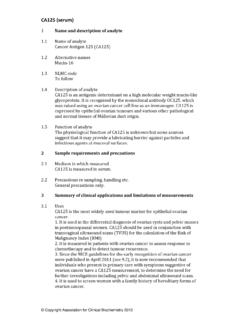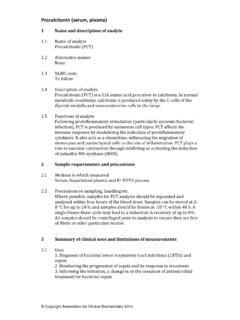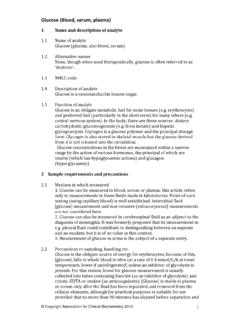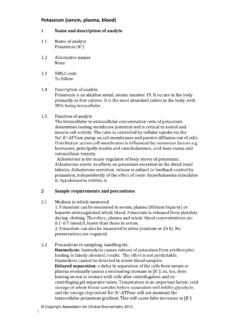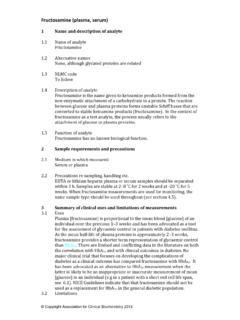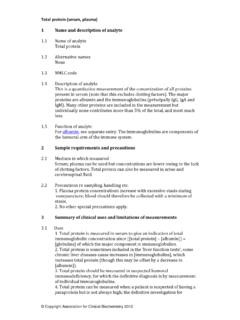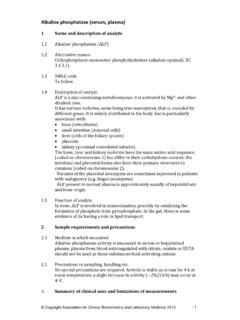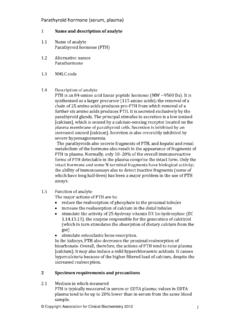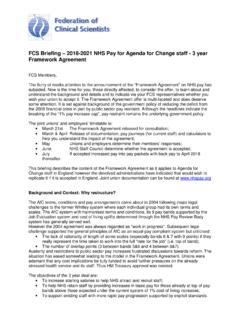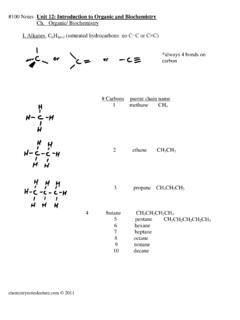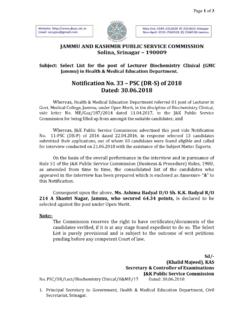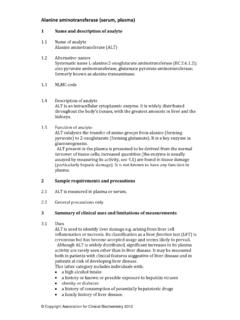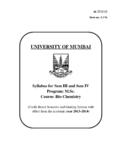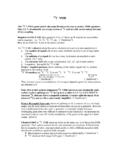Transcription of Cortisol (serum, plasma) - Association for Clinical ...
1 Copyright Association for Clinical biochemistry 2012 Cortisol ( serum , plasma ) 1 Name and description of analyte Name of analyte Cortisol Alternative names Hydrocortisone, 11 ; 17, 21 trihydroxypregn 4 ene 3,20 dione NMLC code Description of analyte Cortisol is the major glucocorticoid synthesised from cholesterol in the adrenal cortex. It also has some mineralocorticoid activity, but this is probably only important in pathological states. Synthesis is stimulated by pituitary adrenocorticotrophic hormone (ACTH); ACTH release is stimulated by corticotrophin releasing hormone (CRH) from the hypothalamus and is inhibited by Cortisol (negative feedback). In the circulation, approximately 75% is protein bound, principally to transcortin ( Cortisol binding globulin, CBG). Function of analyte During the fasting state, Cortisol increases hepatic gluconeogenesis and the peripheral release of substrates, primarily from muscle, required for gluconeogenesis.
2 Cortisol also increases glycerol and free fatty acid release by lipolysis and increases muscle lactate release. Glycogen synthesis and storage by is enhanced by Cortisol . Uptake of glucose in muscle and adipose tissue is inhibited by Cortisol . Cortisol also has anti inflammatory actions through decreasing the migration of imflammatory cells to the sites of injury and inhibiting lymphocyte production. Cortisol secretion is closely regulated by ACTH, which is secreted in an episodic manner superimposed on a circadian rhythm. Cortisol secretion occurs in parallel to the secretion of ACTH. Cortisol secretion is low in the evening and continues to decline into the first few hours of sleep, after which there is an increase. After waking, an individual s Cortisol secretion gradually declines throughout the day, with fewer secretory episodes of smaller magnitude. ACTH (and thus Cortisol ) secretion is stimulated by stress.
3 2 Sample requirements and precautions Medium in which measured 1. Cortisol can be measured in serum or heparinised plasma ; Cortisol can also be measured in urine (see separate entry). 2. Measurements of Cortisol in saliva are used as a surrogate for measurements in serum / plasma . Precautions re sampling, handling etc. Copyright Association for Clinical biochemistry 2012 1. It is usually recommended that stress should be minimised during venepuncture for Cortisol measurement although the importance of doing this has probably been exaggerated. 2. It is recommended that specimens of saliva should be frozen to precipitate salivary glycoproteins and leave a non viscous liquid. 3. Contamination of saliva with blood invalidates salivary measurements. 3 Summary of Clinical uses and limitations of measurements Uses Measurement of Cortisol is used primarily to diagnose and monitor the treatment of Addison s disease and to diagnose Cushings syndrome, disorders of hypocortisolism and hypercortisolism, respectively.
4 Limitations The diagnostic utility of a single Cortisol measurement is limited by the episodic nature of Cortisol secretion, its diurnal variation in concentration and its elevation during stress. Stress may result in patients with adrenal insufficiency having a plasma [ Cortisol ] within the reference range; patients with early Cushing s syndrome may have normal values of [ Cortisol ] during the day despite loss of the diurnal variation. More information is obtained by dynamic testing of the hypothalamic pituitary adrenal (HPA) axis. 4 Analytical considerations Analytical methods 1. Total [ Cortisol ] in serum / plasma a. Chromatographic GC, LC, HPLC and GCMS and LCMS have been used to measure Cortisol . These methods have the advantage of specificity in that they distinguish Cortisol from other steroids and metabolites. However, the methods are labour intensive and require sample processing before analysis.
5 B. Immunoassay This is the most frequently used technique. Cortisol is quantitatively displaced from its binding proteins and measured immunometrically using antibodies supposedly specific to Cortisol . In practice, some cross reactivity, with 11 deoxycortisol or prednisolone is inevitable. 2. Free [ Cortisol ] in saliva Cortisol can be measured in saliva by immunoassay or LCMS. Samples do not require extraction prior to analysis, as the salvia contains very little Cortisol binding proteins or Cortisol metabolites. Reference method Isotope dilution GCMS. Cortisol is extracted from serum and derivatised. Deuterated Cortisol is used as an internal standard. Reference material Cortisol (hydrocortisone) (Standard Reference Material (SRM) 921) available from the National Bureau of Standards, Washington DC, USA. Interfering substances Copyright Association for Clinical biochemistry 2012 Cross reactivity with some synthetic glucocorticoids prednisolone, methylprednisolone and prednisone.
6 Sources of error Studies have shown significant variation in results produced by different methods. 5 Reference intervals and variance Reference intervals (adults) serum [ Cortisol ]: h, 171 536 nmol/L (Roche Elecsys); <50 nmol/L. Salivary [ Cortisol ]: h, 4 28 nmol/L; <5 nmol/L Reference intervals (others) serum [ Cortisol ]: neonatal reference intervals are dependent on gestational age and time since delivery; 1 16 years ( h) 200 700; ( ) <150 nmol/L Extent of variation Interindividual CV: Intraindividual CV: Index of individuality: CV of method typically <3% ( serum ) Critical difference ( serum ): 58 nmol/L Sources of variation Stress, diurnal variation (see and ) 6 Clinical uses of measurement and interpretation of results Uses and interpretation 1. Cortisol can be measured during stimulation of the adrenals and/or pituitary in the investigation of adrenal hypofunction.
7 A [ Cortisol ] >550nmol/L makes primary adrenal hypofunction very unlikely. However, when [CBG] are elevated, higher values are required to exclude adrenal insufficiency (see ). 2. A midnight serum [ Cortisol ] <50 nmol/L excludes, and a value >200 nmol/L has high diagnostic specificity for, adrenal hyperfunction. Cortisol can also be measured after suppression of ACTH release from the pituitary in the investigation of suspected adrenal hyperfunction. 3. Salivary Cortisol is in equilibrium with free Cortisol and can be used as an index of free Cortisol . It is commonly used in children as an alternative to Cortisol measurements in serum . Measurement of a late night salivary Cortisol is becoming increasingly frequently used as an alternative to serum , to determine whether diurnal variation is present in suspected adrenal hyperfunction. Confounding factors 1. Cortisol secretion exhibits a circadian rhythm with highest concentrations occurring in the morning and the lowest at around midnight.
8 2. Cortisol concentrations increase during stress, for example during surgery, acute illness and following trauma. 3. In hyperoestrogenic states, for example during pregnancy, with exogenous oestrogens or with the use of oral contraceptives, [CBG] is Copyright Association for Clinical biochemistry 2012 increased resulting in an elevated total [ Cortisol ] to maintain the equilibrium between free and bound Cortisol ; CBG may also be increased in hyperthyroidism, diabetes and in certain haematological disorders. CBG may be decreased in familial CBG deficiency, hypothyroidism and protein deficiency states such as severe liver disease and nephrotic also decreases on recumbancy. 7 Causes and investigation of abnormal results High concentrations Causes High concentrations are typical of Cushing s syndrome (corticosteroid excess) but can also occur in severe depression and alcoholism. Investigation Suspected Cushing s syndrome should be investigated in two stages.
9 1. Screening tests should be employed to document the presence of hypercortisolism: 24 h urine Cortisol excretion: this is increased in Cushing s syndrome low dose dexamethasone suppression test (dexamethasone mg 6 hourly for 48 h followed by measurement of Cortisol : there is a failure of suppression of Cortisol secretion in Cushing s syndrome ([ Cortisol ] >50nmol/L). (The overnight suppression test in which Cortisol is measured at h after dexamethasone 1 mg the previous night is frequently used but is less specific.) Late night salivary [ Cortisol ]: the diurnal variation in secretion is lost in Cushing s syndrome and nocturnal salivary [ Cortisol ] is raised. 2. Diagnostic tests are used to determine the cause of Cortisol overproduction. ACTH measurement: low [ACTH] suggests an adrenal cause, whereas normal/ high [ACTH] suggests ectopic ACTH secretion or pituitary hypersecretion of ACTH (Cushing s disease) high dose dexamethasone suppression test (dexamethasone 2 mg 6 hourly for 48 h followed by measurement of Cortisol : failure to suppress Cortisol secretion suggests ectopic ACTH secretion or an adrenal cause; in Cushing s disease, [ Cortisol ] typically decreases to <50% of the pre treatment value corticotrophin releasing hormone (CRH) test: (CRH 100 g measurement of Cortisol after 60 minutes): in Cushing s disease, there is typically an increase in [ACTH] and [ Cortisol ]; in ectopic ACTH secretion or adrenal tumours, there is typically no response selective venous sampling; [ACTH] is measured in inferior petrosal vein samples before and after CRH stimulation.))
10 Similar [ACTH] in both petrosal and peripheral vein samples suggests a non pituitary source of ACTH imaging: CT scanning of the adrenal glands and MRI of the pituitary gland can help identify tumours. Low concentrations Causes These are found in adrenal hypofunction, whether of adrenal or hypothalamic/pituitary origin. However, the most frequent cause of a low Copyright Association for Clinical biochemistry 2012 [ Cortisol ] is suppression of the pituitary adrenal axis by synthetic glucocortiocoids given therapeutically Investigation 1. Basal [ Cortisol ] measurement is of limited value but a value of <50 nmol/L at h is effectively diagnostic of adrenal insufficiency, provided the subject is not being treated with synthetic corticosteroids. 2. ACTH stimulation test (250 g tetracosactrin with measurement of Cortisol at 30 minutes): an increase in [ Cortisol ] above 550nmol/L, with an increment >200nmol/L from baseline indicates normal adrenal function.
